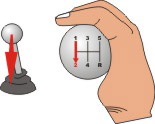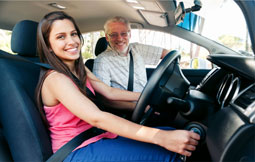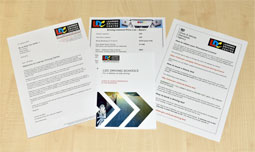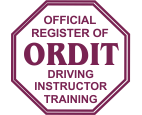Driving lesson 2. Gears
Introduction
Smooth gear changing is the first of three key foundation skills you need to learn, the others being steering and clutch control. Before moving onto Road Skills, part 2 of the Learner Driving programme, it is vitally important that these three foundation skills become second nature to you.
Changing gears
 Gears can be changed up or down. This has nothing to do with the direction you move the gear lever, it simply means that you change to a higher gear (4 or 5) or a lower gear (1 or 2).
Gears can be changed up or down. This has nothing to do with the direction you move the gear lever, it simply means that you change to a higher gear (4 or 5) or a lower gear (1 or 2).
The basic rule is that you change up through the gears as the speed of the car increases and down when you need more power from the engine. For example, you would change down to a lower gear when climbing a hill or pulling away at low speed.
The gears determine the amount of power available from the engine.

First gear provides the most pulling power but the least potential for speed, whilst fifth gear which provides the least pulling power allows the greatest range of speed.
The basic gear changing rule is "brakes to slow - gears to go". As the car increases speed, change up through the gears. When you want to slow down, use the foot brake. You need only change to a lower gear when you need the accelerator again to "drive" the car.
Selective gear changing
Selective gear changing means you sometimes miss out gears, for example, by changing from fifth or fourth gear to second gear. This method is called "selective" or "block" gear changing.
![]() There are also times when you might selectively change up, for example if you have used a lower gear such as third for better acceleration you might be able to change to fifth gear when you have reached your intended cruising speed.
There are also times when you might selectively change up, for example if you have used a lower gear such as third for better acceleration you might be able to change to fifth gear when you have reached your intended cruising speed.
Palming method
To operate the gear lever we use a method known as "palming". You can practice this when the car is stationary and the engine is switched off, but make sure that you keep the clutch pedal pressed down to the floor.
![]() The gear lever will automatically spring to the central neutral position when not in a gear. This is very useful when trying to find and select third or fourth gear.
The gear lever will automatically spring to the central neutral position when not in a gear. This is very useful when trying to find and select third or fourth gear.
 To select first gear place your left hand onto the gear lever, palm away from you. Cup your hand around the gear lever and move it across to the left and forward.
To select first gear place your left hand onto the gear lever, palm away from you. Cup your hand around the gear lever and move it across to the left and forward.
 To move from first to second gear keep your hand on the gear lever, palm away from you, apply slight pressure to the left to stop the gear
To move from first to second gear keep your hand on the gear lever, palm away from you, apply slight pressure to the left to stop the gear
lever springing back to the central neutral position, and move the gear lever straight back.
 Now move your hand so that your palm is facing you, cupping the gear lever. Move the gear lever forward, allow it to spring into the central neutral position then move it forward to select third gear.
Now move your hand so that your palm is facing you, cupping the gear lever. Move the gear lever forward, allow it to spring into the central neutral position then move it forward to select third gear.
 Keeping your hand in the same position, move the gear lever straight back to select fourth gear.
Keeping your hand in the same position, move the gear lever straight back to select fourth gear.
 To select fifth gear keep your hand in the same position and move the gear lever forwards, across to the right against the neutral spring and forwards.
To select fifth gear keep your hand in the same position and move the gear lever forwards, across to the right against the neutral spring and forwards.
How to change gear
The correct sequence for changing gear is as follows:
 Make sure that it is safe to change gear. Any place where it is necessary to use both hands to steer the car, such as a corner or bend would not be suitable.
Make sure that it is safe to change gear. Any place where it is necessary to use both hands to steer the car, such as a corner or bend would not be suitable.- Next, ease off the accelerator pedal just prior to depressing the clutch pedal. The two actions are almost simultaneous.
 Select the appropriate gear using your left hand while being careful to look ahead and not at the gear lever.
Select the appropriate gear using your left hand while being careful to look ahead and not at the gear lever.- Release the clutch pedal just prior to reapplying pressure to the accelerator pedal with your right foot. Again the two actions are almost simultaneous.
This will dramatically reduce the power being transmitted from the engine to the gearbox, enabling you to select a gear without causing any damage to the gear mechanism.
Highway Code study
Rule: 122











